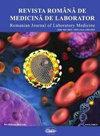剥脱细胞学联合CA125、CEA、NSE、CYFRA21-1、CA15-3对肺癌的诊断价值
IF 0.5
4区 医学
Q4 MEDICINE, RESEARCH & EXPERIMENTAL
引用次数: 0
摘要
摘要背景:探讨剥脱细胞学联合肿瘤标志物碳水化合物抗原125 (CA125)、癌胚抗原(CEA)、神经元特异性烯醇酶(NSE)、细胞角蛋白19片段抗原21-1 (CYFRA21-1)、CA15-3检测对肺癌的诊断价值。方法:共纳入256例患者,其中男性164例,女性92例,年龄(64.51±22.68)岁。其中,随机选取189例患者(男100例,女89例)作为肿瘤组,其余67例患者进行验证。另选取同期在我院体检的健康人群514例,其中随机抽取397例(男266例,女131例)作为无肿瘤组,其余117例作为验证组。所有受试者均进行生化指标检测。采用受试者工作特征(ROC)曲线分析各指标对肺癌的诊断价值。结果:ROC曲线分析结果显示,肿瘤组剥脱性细胞学、CA125、CYFRA21-1、CA15-3、CEA、NSE的曲线下面积(AUC)≥0.7,而CA72-4、CA19-9、TSGF、AFP、CA242、SCCAg、CA50的曲线下面积(AUC) <0.7。综合评价各因素指标,筛选剥脱细胞学、CA125、CA15-3、CYFRA21-1、CEA、NSE,建立肺癌预测模型。预测模型与9项指标联合检测的诊断价值相当(Z=1.682, P=0.079)。结论:肺癌预测模型在不降低诊断效率的前提下平衡了敏感性和特异性。本文章由计算机程序翻译,如有差异,请以英文原文为准。
Diagnostic value of combination of exfoliative cytology with CA125, CEA, NSE, CYFRA21-1 and CA15-3 for lung cancer
Abstract Background: To explore the diagnostic value of combination of exfoliative cytology with detection of tumor markers carbohydrate antigen 125 (CA125), carcinoembryonic antigen (CEA), neuron specific enolase (NSE), cytokeratin 19 fragment antigen 21-1 (CYFRA21-1) and CA15-3 for lung cancer. Methods: A total of 256 patients were enrolled, including 164 males and 92 females aged (64.51±22.68) years old. Among them, 189 patients (100 males and 89 females) were randomly selected as Tumor group, and the remaining 67 patients were used for validation. Another 514 healthy people receiving physical examination in our hospital during the same period were selected, from which 397 cases (266 males and 131 females) were randomly selected as No Tumor group, and the remaining 117 cases were used for validation. The biochemical criteria were detected in all subjects. The diagnostic value of each index for lung cancer was analyzed using receiver operating characteristic (ROC) curves. Results: The results of ROC curve analysis revealed that in Tumor group, the area under curve (AUC) of exfoliative cytology, CA125, CYFRA21-1, CA15-3, CEA and NSE was ≥0.7, while that of CA72-4, CA19-9, TSGF, AFP, CA242, SCCAg and CA50 was <0.7. The indices in each factor were comprehensively assessed, and then exfoliative cytology, CA125, CA15-3, CYFRA21-1, CEA and NSE were screened to establish the lung cancer prediction model. The diagnostic value was comparable between the prediction model and the combined detection of 9 indices (Z=1.682, P=0.079). Conclusions: The lung cancer prediction model balances sensitivity and specificity without reducing the diagnostic efficiency.
求助全文
通过发布文献求助,成功后即可免费获取论文全文。
去求助
来源期刊

Revista Romana De Medicina De Laborator
MEDICINE, RESEARCH & EXPERIMENTAL-
CiteScore
0.31
自引率
20.00%
发文量
43
审稿时长
>12 weeks
期刊介绍:
The aim of the journal is to publish new information that would lead to a better understanding of biological mechanisms of production of human diseases, their prevention and diagnosis as early as possible and to monitor therapy and the development of the health of patients
 求助内容:
求助内容: 应助结果提醒方式:
应助结果提醒方式:


